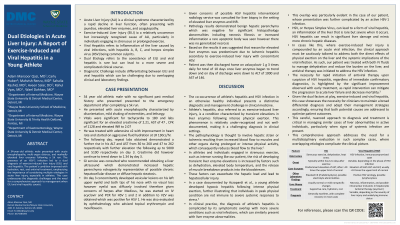Monday Poster Session
Category: Liver
P3081 - Dual Etiologies in Acute Liver Injury: A Report of Exercise-Induced and Viral Hepatitis in a Young Athlete
Monday, October 28, 2024
10:30 AM - 4:00 PM ET
Location: Exhibit Hall E

Has Audio

Adam M. Qazi, MD
Detroit Medical Center/Wayne State University
Troy, MI
Presenting Author(s)
Adam M. Qazi, MD1, Carly Hubers, 2, Kendall Conway, 2, Mahvish Renzu, MD3, Sahalia Rashid, MD, PhD4, Rahul Vyas, MD5, Aveen Salar, DO6
1Detroit Medical Center/Wayne State University, Troy, MI; 2Wayne State University School of Medicine, Detroit, MI; 3Trinity Health Oakland / Wayne State University School of Medicine, Troy, MI; 4Wayne State University School of Medicine / Detroit Medical Center, Detroit, MI; 5Detroit Medical Center, Rochester Hills, MI; 6Wayne State University, Macomb, MI
Introduction: Acute liver injury in athletes presents diagnostic challenges. Distinguishing between exercise-induced liver injury and liver damage from infectious etiologies is complex and necessitates a nuanced understanding of underlying mechanisms. This report highlights a rare instance of acute liver injury triggered by physical exertion, further complicated by a concurrent viral infection. This case shows the interplay of physical exertion and viral infection contributing to severe symptoms, emphasizing the need for alertness among clinicians to manage such overlapping conditions effectively.
Case Description/Methods: A 34-year-old previously healthy male developed acute encephalopathy following a 5k run. He presented with disorientation, tachycardia and myalgia, which escalated to multi-organ distress. Elevated liver enzymes (AST/ALT peaking at 5100/ >5k) and transient troponinemia indicated severe hepatic injury. Further complications arose with the onset of HSV-1 infection symptoms, including unilateral conjunctivitis, which contributed to a dual diagnosis of exercise-induced liver injury and viral hepatitis. The evaluation included cardiac, renal, and hepatic workup, and infectious disease consultation, which confirmed HSV-1.
Discussion: This case calls attention to the diagnostic challenges in acute liver injury with overlapping exercise-induced and infectious causes. Exercise-induced liver injury, or athlete’s hepatitis, involves transient liver enzyme elevations from hepatic strain or ischemia during exertion. In our patient, the presentation initially pointed towards an exercise-induced etiology. However, the coexisting HSV-1 infection added complexity, mimicking similar liver enzyme abnormalities. The rapid initiation of antiviral therapy upon suspicion of infection, before diagnostic confirmation, was crucial and stresses the importance of timely intervention. This approach not only helped in managing the infection, but also mitigated the risk of progressing to acute liver failure. The relationship between athlete’s hepatitis and HSV-1 adds to discussions on athletic health and safety, urging clinicians to maintain a broad differential diagnosis in similar cases. It highlights the need for a multidisciplinary approach that includes timely interventions. The patient's improvement with hydration and antivirals validates the diagnosis of dual etiology, emphasizing that both infectious and non-infectious agents can simultaneously impact liver health.
Disclosures:
Adam M. Qazi, MD1, Carly Hubers, 2, Kendall Conway, 2, Mahvish Renzu, MD3, Sahalia Rashid, MD, PhD4, Rahul Vyas, MD5, Aveen Salar, DO6. P3081 - Dual Etiologies in Acute Liver Injury: A Report of Exercise-Induced and Viral Hepatitis in a Young Athlete, ACG 2024 Annual Scientific Meeting Abstracts. Philadelphia, PA: American College of Gastroenterology.
1Detroit Medical Center/Wayne State University, Troy, MI; 2Wayne State University School of Medicine, Detroit, MI; 3Trinity Health Oakland / Wayne State University School of Medicine, Troy, MI; 4Wayne State University School of Medicine / Detroit Medical Center, Detroit, MI; 5Detroit Medical Center, Rochester Hills, MI; 6Wayne State University, Macomb, MI
Introduction: Acute liver injury in athletes presents diagnostic challenges. Distinguishing between exercise-induced liver injury and liver damage from infectious etiologies is complex and necessitates a nuanced understanding of underlying mechanisms. This report highlights a rare instance of acute liver injury triggered by physical exertion, further complicated by a concurrent viral infection. This case shows the interplay of physical exertion and viral infection contributing to severe symptoms, emphasizing the need for alertness among clinicians to manage such overlapping conditions effectively.
Case Description/Methods: A 34-year-old previously healthy male developed acute encephalopathy following a 5k run. He presented with disorientation, tachycardia and myalgia, which escalated to multi-organ distress. Elevated liver enzymes (AST/ALT peaking at 5100/ >5k) and transient troponinemia indicated severe hepatic injury. Further complications arose with the onset of HSV-1 infection symptoms, including unilateral conjunctivitis, which contributed to a dual diagnosis of exercise-induced liver injury and viral hepatitis. The evaluation included cardiac, renal, and hepatic workup, and infectious disease consultation, which confirmed HSV-1.
Discussion: This case calls attention to the diagnostic challenges in acute liver injury with overlapping exercise-induced and infectious causes. Exercise-induced liver injury, or athlete’s hepatitis, involves transient liver enzyme elevations from hepatic strain or ischemia during exertion. In our patient, the presentation initially pointed towards an exercise-induced etiology. However, the coexisting HSV-1 infection added complexity, mimicking similar liver enzyme abnormalities. The rapid initiation of antiviral therapy upon suspicion of infection, before diagnostic confirmation, was crucial and stresses the importance of timely intervention. This approach not only helped in managing the infection, but also mitigated the risk of progressing to acute liver failure. The relationship between athlete’s hepatitis and HSV-1 adds to discussions on athletic health and safety, urging clinicians to maintain a broad differential diagnosis in similar cases. It highlights the need for a multidisciplinary approach that includes timely interventions. The patient's improvement with hydration and antivirals validates the diagnosis of dual etiology, emphasizing that both infectious and non-infectious agents can simultaneously impact liver health.
Disclosures:
Adam Qazi indicated no relevant financial relationships.
Carly Hubers indicated no relevant financial relationships.
Kendall Conway indicated no relevant financial relationships.
Mahvish Renzu indicated no relevant financial relationships.
Sahalia Rashid indicated no relevant financial relationships.
Rahul Vyas indicated no relevant financial relationships.
Aveen Salar indicated no relevant financial relationships.
Adam M. Qazi, MD1, Carly Hubers, 2, Kendall Conway, 2, Mahvish Renzu, MD3, Sahalia Rashid, MD, PhD4, Rahul Vyas, MD5, Aveen Salar, DO6. P3081 - Dual Etiologies in Acute Liver Injury: A Report of Exercise-Induced and Viral Hepatitis in a Young Athlete, ACG 2024 Annual Scientific Meeting Abstracts. Philadelphia, PA: American College of Gastroenterology.
